
Henri IV de Sully (died 1336), Grand Butler of France, Treasurer of France, Lord of Sully was a 13th-14th century French noble.

Henri IV de Sully (died 1336), Grand Butler of France, Treasurer of France, Lord of Sully was a 13th-14th century French noble.
Henri IV de Sully was the eldest son of Henri III de Sully and Marguerite de Bommiers. [1]
Sully was an adviser to King Philip IV of France at the end of his reign, and tutored Phillip's younger son Count Philip de Poitiers. In 1316, Sully supported the latter at his accession to the regency and the throne of France as King Philip V of France, and was rewarded by receiving the prestigious office of Grand Butler of France in 1317.
Sully played a key role in the administration of the kingdom by becoming Treasurer of France. He also played a key diplomatic role, participating in the reconciliation between Philip V and his cousin Robert III of Artois. In 1318, Sully was sent as an embassy to Pope John XXII. The same year, Sully was involved in a major dispute with Beraud de Mercœur, a royal adviser, whom Sully accused of treason. The king had to intervene to settle the quarrel between the two men.
Philip V died on 3 January 1322. His brother Charles succeeded him as King Charles IV and replaced Sully as head of the Treasury with Pierre de Rémi. In October 1322, Sully was captured by the Scots at the Battle of Old Byland. Sully however was honoured as a guest by King Robert the Bruce who required no ransom and Sully helped to negotiate a truce between the Scots and English the following year. [2] He was sent as an ambassador to Westminster by Charles IV, to arrange the marriage of his daughter with the eldest son of the King Edward II of England. Sully appears to have found favour with Edward II and was appointed Seneschal of Gascony in 1325–26. In 1329, Sully was appointed by Philip III of Navarre as governor of the Kingdom of Navarre. During this appointment, Sully undertook diplomatic negotiations aiming to launch a crusade against the Kingdom of Granada, but the crusade did not eventuate. In 1335, Navarre declared war against the Kingdom of Aragon, with Sully taking charge of the defence of the small Pyrenean kingdom. He died in 1336 and was succeeded by his son Jean.
Henri IV married Jeanne, daughter of Jean V de Vendôme and Éléonore de Montfort, [3] and had the following known issue:
The Capetian dynasty, also known as the "House of France", is a dynasty of European origin, and a branch of the Robertians and the Karlings. It is among the largest and oldest royal houses in Europe and the world, and consists of Hugh Capet, the founder of the dynasty, and his male-line descendants, who ruled in France without interruption from 987 to 1792, and again from 1814 to 1848. The senior line ruled in France as the House of Capet from the election of Hugh Capet in 987 until the death of Charles IV in 1328. That line was succeeded by cadet branches, the Houses of Valois and then Bourbon, which ruled without interruption until the French Revolution abolished the monarchy in 1792. The Bourbons were restored in 1814 in the aftermath of Napoleon's defeat, but had to vacate the throne again in 1830 in favour of the last Capetian monarch of France, Louis Philippe I, who belonged to the House of Orléans. Cadet branches of the Capetian House of Bourbon are still reigning over Spain and Luxembourg.

The House of Bourbon is a dynasty that originated in the Kingdom of France as a branch of the Capetian dynasty, the royal House of France. Bourbon kings first ruled France and Navarre in the 16th century. A branch descended from the French Bourbons came to rule Spain in the 18th century and is the current Spanish royal family. Further branches, descended from the Spanish Bourbons, held thrones in Naples, Sicily, and Parma. Today, Spain and Luxembourg have monarchs of the House of Bourbon. The royal Bourbons originated in 1272, when Robert, the youngest son of King Louis IX of France, married the heiress of the lordship of Bourbon. The house continued for three centuries as a cadet branch, serving as nobles under the direct Capetian and Valois kings.
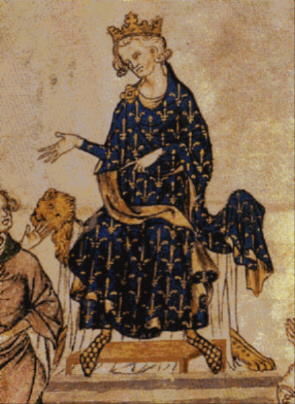
Philip VI, called the Fortunate or the Catholic and of Valois, was the first king of France from the House of Valois, reigning from 1328 until his death in 1350. Philip's reign was dominated by the consequences of a succession dispute. When King Charles IV of France died in 1328, his nearest male relative was his nephew, King Edward III of England, but the French nobility preferred Charles's paternal cousin, Philip.

Maximilien de Béthune Sully, 1st Prince of Sully, Marquis of Rosny and Nogent, Count of Muret and Villebon, Viscount of Meaux was a nobleman, soldier, statesman, and counselor of King Henry IV of France. Historians emphasize Sully's role in building a strong centralized administrative system in France using coercion and highly effective new administrative techniques. While not all of his policies were original, he used them well to revitalize France after the European Religious Wars. Most, however, were repealed by later monarchs who preferred absolute power. Historians have also studied his Neostoicism and his ideas about virtue, prudence, and discipline.
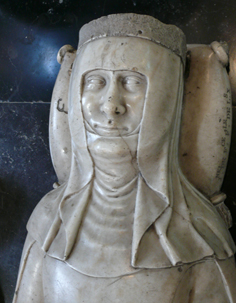
Joan II was Queen of Navarre from 1328 until her death. She was the only surviving child of Louis X of France, King of France and Navarre, and Margaret of Burgundy. Joan's paternity was dubious because her mother was involved in a scandal, but Louis X declared her his legitimate daughter before he died in 1316. However, the French lords were opposed to the idea of a female monarch and elected Louis X's brother, Philip V, king. The Navarrese noblemen also paid homage to Philip. Joan's maternal grandmother, Agnes of France, and uncle, Odo IV of Burgundy, made attempts to secure the counties of Champagne and Brie to Joan, but the French royal troops defeated her supporters. After Philip V married his daughter to Odo and granted him two counties as her dowry, Odo renounced Joan's claim to Champagne and Brie in exchange for a compensation in March 1318. Joan married Philip of Évreux, who was also a member of the French royal family.
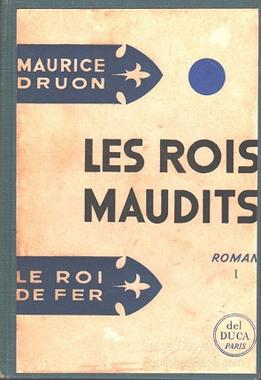
The Accursed Kings is a series of historical novels by French author Maurice Druon about the French monarchy in the 14th century. Published between 1955 and 1977, the series has been adapted as a miniseries twice for television in France.

Philip III, called the Noble or the Wise, was King of Navarre from 1328 until his death. He was born a minor member of the French royal family but gained prominence when the Capetian main line went extinct, as he and his wife and cousin, Joan II of Navarre, acquired the Iberian kingdom and a number of French fiefs.
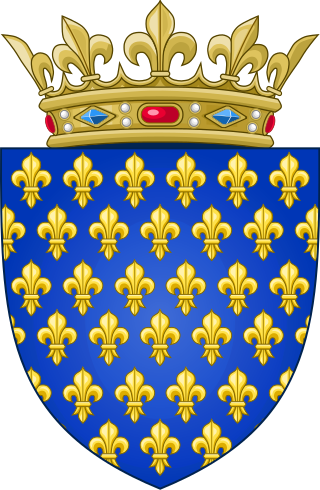
The House of Capet ruled the Kingdom of France from 987 to 1328. It was the most senior line of the Capetian dynasty – itself a derivative dynasty from the Robertians.
Philip ΙΙ of Montfort was a French nobleman, Count of Squillace in Italy from 1266/68, then Lord of Castres in 1270. He was the son of Philip I of Monfort, Lord of Tyre and Eleonore of Courtenay. His coat-of-arms was Gules, a lion rampant double queued argent, a label of four points azure.

Louis of Évreux was a prince, the only son of King Philip III of France and his second wife Maria of Brabant, and thus a half-brother of King Philip IV of France.

Gaston IV was the sovereign Viscount of Béarn and the Count of Foix and Bigorre in France from 1436 to 1472. He also held the viscounties of Marsan, Castelbon, Nébouzan, Villemeur and Lautrec and was, by virtue of the county of Foix, co-prince of Andorra. From 1447 he was also Viscount of Narbonne. Through his marriage to Eleanor, heiress of the Kingdom of Navarre, he also held the title of Prince of Navarre.

Robert IV of Dreux (1241–1282), Count of Dreux, Braine and Montfort-l'Amaury, was the son of John I of Dreux and Marie of Bourbon.

Françoise d'Alençon was the eldest daughter of René of Alençon and Margaret of Lorraine, and the younger sister and despoiled heiress of Charles IV, Duke of Alençon.
Castres-en-Albigenses was a dependence of the Viscount of Albi. The Viscounts of Albi granted Castres a city charter establishing a commune with the city, headed by consuls. During the Albigensian Crusade, the city quickly surrendered to Simon de Montfort, who gave it to his brother Guy de Montfort.

Jeanne d'Albret, also known as Jeanne III, was Queen of Navarre from 1555 to 1572.
Prince of Guémené is a title of French nobility associated with the fiefdom of Guémené-sur-Scorff in Brittany and held within the House of Rohan. The fiefdom was bought on 26 May 1377, for 3,400 sous d'or by Jean de Rohan, Viscount of Rohan. From his second marriage to Jeanne de Navarre the couple had two children; the eldest Alain became the Viscount of Rohan. That branch became extinct in 1527. The younger child, Charles, was given the fiefdom of Guémené.

Godfrey of Brabant, was Lord of Aarschot, between 1284 and his death in 1302, and Lord of Vierzon, between 1277 and 1302.

Amaury III de Craon, Lord of Créon, Mareuil and Sablé, Seneschal of Gascony as well as seneschal of Anjou, Maine and Touraine.
the Lords of Robecque, (Robecq) belonged to the Feudal Belgian nobility, Robecque is in Artois, now France.
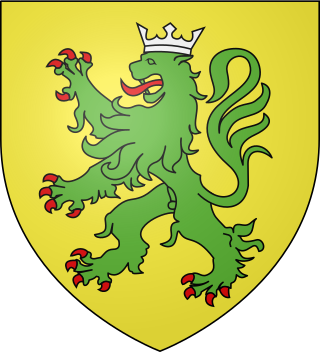
Robert VIII Bertrand de Bricquebec, also known as Robert Bertrand, Baron of Bricquebec, Viscount of Roncheville, was a 14th century Norman noble. He served as Marshal of France from 1325 until 1344.